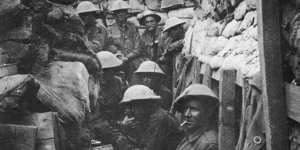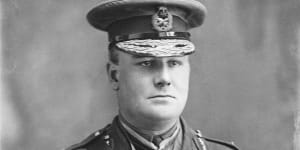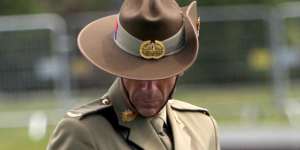Just as it has been for the past 11 decades,many emotions will resonate – reverence and respect,amid remembrance.
I submit that,all these years on,one emotion is painfully missing,and it is time it was aired,at least once.

Diggers in the trenches at Fromelles.Australian War Memorial
Rage.
Rage,at so many of our Diggers so needlessly slaughtered on insane battle plans that never had any chance of succeeding.
Rage,at the complete lack of remorse from those who sent them to their deaths.
Rage,at the generals’ refusal to learn from previous catastrophes to prevent the next one.
I know. I know. Already,I am in the middle of no man’s land with Paul Keating,taking fire from ourown lines. For it was Keating who – on the occasion of the 30th anniversary of the unveiling of the Tomb of the Unknown Soldier – derided the First World War as a “quagmire of European tribalism”.
The commentariat counterattacks on Keating went for days,with the broad theme being that by denying the nobility of the Great War,he was spitting on the graves of the Australians who died.
Keating being Keating,he never wavered a jot and stuck to his guns.

Harold “Pompey” Elliott.Australian War Memorial
And I will too,because after doing books on this stuff over the past couple of decades,of wading through diaries and letters and the overwhelming grief of those left behind,I feel it too strongly not to say it,and back it.
Let me spell it out. Eleven decades on from the horrors of Lone Pine,of The Nek,of Fromelles,of Bullecourt and the like,I am yet to see a thunderous piece of writing saying what needed to be said at the time,and since:“You BASTARDS! Howcould you send so many men to their certain deaths? Where was your shame,your remorse,your grief for what you so uselessly wrought? You callous mongrels!”
This rage came to me most strongly when writing a book on the Battle of Fromelles. It was on the Western Front in July of 1916,and the plan was simple:send four waves of Australian soldiers,7000 in all,over the top in broad daylight,across 400 yards of marshy ground with no cover,straight at a German bunker bristling with machine guns,capable of firing 600 bullets a minute.
The first Australian general to wrestle with the plan was the great Melburnian Pompey Elliott. He realised the whole idea of this thrust had been formed by two English officers,General Sir Richard Haking and General Sir Charles Monro,who had not evenseen the ground they were ordering the Australians to attack,and this resulted “in selection of unsuitable ground commanded everywhere by enemy observation and fire”.
‘We cannot succeed’
Desperate to stop something he knows will cause carnage on an unimaginable scale,General Elliott takes a highly placed English officer from British General HQ,Major Harry Howard,to come and inspect the ground three days before the battle is scheduled.
He steers the Englishman towards VC Corner,to the east of the German bunker,the Sugar Loaf.
Do you see,Major Howard?
To get to it,to evenbegin to attack it,my men will have to cover four marshy football fields of open ground,under fire from shot and shell,shattered by shrapnel.
“Major,” Elliott says firmly,brandishing a pamphlet the British had issued the Australians on how to best fight on the Western Front,“I want you now to tell me as man to man … whether this attack can succeed,for according to the axioms laid down in this pamphlet which your staff has issued to us wecannotsucceed.”
Major Howard is stunned. This isnot the way things are done in the British Army. One does not speak “man to man”. One speaks by rank,and is sniffingly superior or cloyingly deferential,accordingly. What to do? The Englishman pauses before gathering himself.
“Sir,” he says to Elliott,“since you have put it to me in that way,I must answer,but I expect the result to be ‘a bloody holocaust’.”
Well,get these orders changed!
They weren’t.
Our blokes went over the top on the late afternoon of July 19,1916.
A contemporary account describes the scene,and – a century on – we all should read it and weep:“Stammering scores of German machine guns spluttered violently,drowning the noise of the cannonade. The air was thick with bullets,swishing in a flat criss-crossed lattice of death ... Hundreds were mown down in the flicker of an eyelid,like great rows of teeth knocked from a comb ... Men were cut in two by streams of bullets[that] swept like whirling knives ... It was the charge of the Light Brigade once more,but more terrible,more hopeless.”
Fourteen hours later,this was the scene,and,again,for those Diggers all these years later,we all should read it andrage.
“The sight of our trenches that next morning is burned into my brain,” Corporal Hugh Knyvett of the 15th Brigade would recount.
“In places,the parapet was repaired with bodies – bodies that but yesterday had housed the personality of a friend by whom we had warmed ourselves. If you had gathered the stock of a thousand butcher shops,cut it into small pieces and strewn it about,it would give you a faint conception of the shambles those trenches were.”
Australia suffered 5500 casualties in that insane battle. No fewer than 1850 of our great-grandfathers,grand-uncles and great-grand-uncles were killed – nearly four times as many as were killed in the entire Vietnam War. Not a yard of trench was taken.
All those Australian deaths because of a plan the English knew would result in a “holocaust”! Across our brown land,that meant 1850 “death knocks”,the cable boy delivering those devastating telegrams:“It is my painful duty to have to inform you the sad news of the death of your son,Private …”
Where was the rage? Pompey Elliott felt it,and his biographer,Ross McMullin,confirms Pompey’s inability to stop the insanity was a factor in him taking his own life a decade later.
But in the public domain? Rage was barely there for several reasons. At the time,little was known of the details in Australia,and it would not be for a long time. Following the news of the tragic death of a family member,the family and the nation itself wanted to believe their tragic loss was for the greater good,their son and brother died in a worthy battle – their death,their sacrifice was worthit.
Well,not at Fromelles it bloody well wasn’t! Nor was it at Lone Pine,where there were 2000 Digger casualties in hours.
Nor at the Nek,where 372 were killed or wounded in minutes,charging in four waves straight at Turkish guns across just 50 yards. Nor at the First Battle of Bullecourt,which I have been writing about recently for a book on Albert Jacka,VC. In the first attempt to attack heavily defended German lines,our blokes were given just a few hours’ notice they would be working with tanks. There was no time to acquaint themselves with those tanks,the terrain or the plan,which had first come from the English commander of the Fifth Army Corps,General Sir Hubert Gough. He was highly regarded by Field Marshall Douglas Haig as “a thruster”,one who would gain ground without quibbling about casualties. Great.
The result was a sheer,useless mass slaughter of Australian and British lives – the Australian 4th Division lost just under 3500 wounded and killed – and when the battle was over,again,we had not gained a single yard of trench. Where was the rage? Albert Jacka certainly felt it,and reportedly nearly punched the lights out of one British tank crew that abandoned the field,and later an English cavalry officer who ventured too close to his fury. But in the public domain,for the same reasons as above,there was little expression of it.
To be sure,wantonly wasting Australian lives was not the exclusive preserve of English generals. Straight after the Battle of Fromelles,Australian General James McCay refused the offer of a German truce,which would have allowed our stretcher-bearers to get our men. GHQ was insistent that “no negotiations of any kind,and on any subject,were to be had with the enemy ...”
After the war,Albert Jacka publicly refused to shake “Butcher” McCay’s hand.
The English officers displayed similar appalling callousness towards theirown soldiers.
“Consider the casualties,” foreign secretary Lord Balfour once told the English army supremo,Lord Kitchener. “There must have been nearly 10,000 men lost in these engagements.”
“Eight thousand seven hundred at Neuve Chapelle,” Kitchener corrected him blandly,“but it isn’t the men I mind. I can replace the men at once,but I can’t replace the shells so easily.”

A lone Australian soldier inspects the empty cemetery after the ceremony to dedicate Fromelles Military Cemetery in July 2010.Penny Bradfield
More than a sniffy disdain for Australian lives lost,it seems to me to be more of a sniffy disdain forlower-class lives lost,and for them,saying “Australian lower class” was a tautology.
Either way,when it came to Australians being slaughtered so uselessly in the Great War,it continued until May 1918,when a revolutionary thing took place. Given this was anAustralian army filled withAustralian soldiers,perhaps let’s put anAustralian general in charge?
Against massive resistance – for there remained a strong view that the English were innately better at commanding Australians than Australians themselves,an idea that tragically persists among monarchists to this day – General Sir John Monash took over,and things immediately improved,as he valued Australian lives and no longer wantonly wasted them.
This was too late for tens of thousands of Diggers,and of course my raging now will do nothing to bring them back or avenge them. But somewhere,some time,it simply had to be said in the public domain.
You BASTARDS. Howcould you have killed so many of our Diggers?
I rage against the dying of their light.